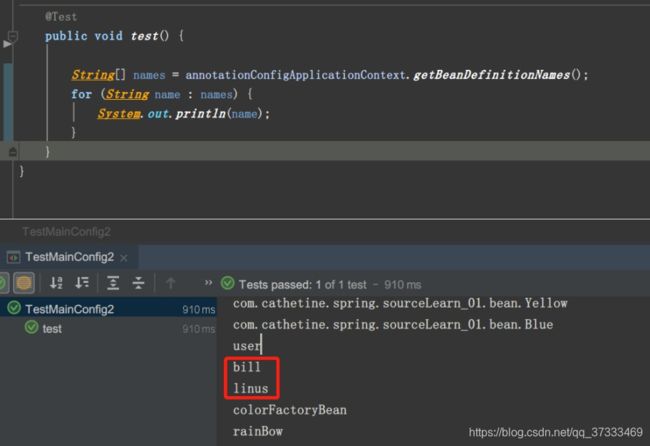Spring @Conditional注解的使用
Spring @Conditional注解的使用
@Conditional是Spring4新提供的注解,它可以标注在类或者方法上,它的作用是按照一定的条件进行判断,满足条件给容器注册bean。
/**
* Indicates that a component is only eligible for registration when all
* {@linkplain #value specified conditions} match.
*
* A condition is any state that can be determined programmatically
* before the bean definition is due to be registered (see {@link Condition} for details).
*
*
The {@code @Conditional} annotation may be used in any of the following ways:
*
* - as a type-level annotation on any class directly or indirectly annotated with
* {@code @Component}, including {@link Configuration @Configuration} classes
* - as a meta-annotation, for the purpose of composing custom stereotype
* annotations
* - as a method-level annotation on any {@link Bean @Bean} method
*
*
* If a {@code @Configuration} class is marked with {@code @Conditional},
* all of the {@code @Bean} methods, {@link Import @Import} annotations, and
* {@link ComponentScan @ComponentScan} annotations associated with that
* class will be subject to the conditions.
*
*
NOTE: Inheritance of {@code @Conditional} annotations
* is not supported; any conditions from superclasses or from overridden
* methods will not be considered. In order to enforce these semantics,
* {@code @Conditional} itself is not declared as
* {@link java.lang.annotation.Inherited @Inherited}; furthermore, any
* custom composed annotation that is meta-annotated with
* {@code @Conditional} must not be declared as {@code @Inherited}.
*
* @author Phillip Webb
* @author Sam Brannen
* @since 4.0
* @see Condition
*/
@Target({ElementType.TYPE, ElementType.METHOD})
@Retention(RetentionPolicy.RUNTIME)
@Documented
public @interface Conditional {
/**
* All {@link Condition}s that must {@linkplain Condition#matches match}
* in order for the component to be registered.
*/
Class<? extends Condition>[] value();
}
从源码中可以看出,@Conditional使用时必须传入一个继承了Condition类的class类,接着我们看看Condition接口:
/**
* A single {@code condition} that must be {@linkplain #matches matched} in order
* for a component to be registered.
*
* Conditions are checked immediately before the bean-definition is due to be
* registered and are free to veto registration based on any criteria that can
* be determined at that point.
*
*
Conditions must follow the same restrictions as {@link BeanFactoryPostProcessor}
* and take care to never interact with bean instances. For more fine-grained control
* of conditions that interact with {@code @Configuration} beans consider the
* {@link ConfigurationCondition} interface.
*
* @author Phillip Webb
* @since 4.0
* @see ConfigurationCondition
* @see Conditional
* @see ConditionContext
*/
public interface Condition {
/**
* Determine if the condition matches.
* @param context the condition context
* @param metadata metadata of the {@link org.springframework.core.type.AnnotationMetadata class}
* or {@link org.springframework.core.type.MethodMetadata method} being checked.
* @return {@code true} if the condition matches and the component can be registered
* or {@code false} to veto registration.
*/
boolean matches(ConditionContext context, AnnotatedTypeMetadata metadata);
}
该接口的意思就是我们使用@Conditional注解时必须同时传入实现该接口的类并重写matches(ConditionContext context, AnnotatedTypeMetadata metadata)方法,如果方法返回true,就会加载对应的bean到IOC容器中,如果返回false,就不返回。
接下来看看怎么用这个注解:
我们先用@Configuration和@Bean往容器中添加两个用户,分别是linus和bill:
@Configuration
public class MainConfig2 {
@Bean("bill")
public User user01() {
User user = new User();
user.setUserName("bill gates");
user.setNation("USA");
return user;
}
@Bean("linus")
public User user02() {
User user = new User();
user.setUserName("linus");
user.setNation("USA");
return user;
}
}
接下来看看测试类:
public class TestMainConfig2 {
AnnotationConfigApplicationContext annotationConfigApplicationContext;
@Before
public void before() {
annotationConfigApplicationContext
= new AnnotationConfigApplicationContext(MainConfig2.class);
}
@Test
public void test() {
String[] names = annotationConfigApplicationContext.getBeanDefinitionNames();
for (String name : names) {
System.out.println(name);
}
}
}
看看输出:

两个bean都被注入了,接下来我们想要添加条件,即在linux操作系统下才注入linus这个用户,这个时候我们就需要用上@Conditional注解了,我们先写一个LinuxCondition类实现Condition接口:
public class LinuxCondition implements Condition {
/**
* ConditionContext:判断条件能使用的上下文(环境)
* AnnotatedTypeMetadata:注释信息
*/
@Override
public boolean matches(ConditionContext context, AnnotatedTypeMetadata metadata) {
// TODO是否linux系统
//1、能获取到ioc使用的beanfactory
ConfigurableListableBeanFactory beanFactory = context.getBeanFactory();
//2、获取类加载器
ClassLoader classLoader = context.getClassLoader();
//3、获取当前环境信息
Environment environment = context.getEnvironment();
//4、获取到bean定义的注册类
BeanDefinitionRegistry registry = context.getRegistry();
String property = environment.getProperty("os.name");
//可以判断容器中的bean注册情况,也可以给容器中注册bean
boolean definition = registry.containsBeanDefinition("person");
System.out.println("contains person:" + definition);
if(property.contains("linux")){
return true;
}
return false;
}
}
然后在bill的bean上加入@Conditional(LinuxCondition .class):
@Bean("linus")
@Conditional(LinuxCondition .class)
public User user01() {
User user = new User();
user.setUserName("linus");
user.setNation("USA");
return user;
}
这个时候,我们再来看看linus这个bean有没有被注入到容器中,进行test查看打印数据:

可以看到linus这个用户已经没有被注入到容器中了。
